The holy shrine of Badrinath is approx 45 kms from the town of Joshimath. Joshimath acts like a main gateway for many places in that part of the Uttarakhand. Many tourists and pilgrims arrive at Joshimath by the evening, stay there in the night and proceed onward to Badrinath, Auli or Valley of Flowers on the next day. We also arrived there in the afternoon by a bus from Haridwar. Although our bus was going upto Badrinath, but we were in no hurry to reach there on the same day, so we stepped down at Joshimath to explore the town.
Next day morning, walking through the sleepy town of Joshimath, we reached at the Jeep stand to catch a shared Jeep for Badrinath. It was located on the upper market road in Joshimath. Slight rain was there, but we were hopeful to get the vehicle in the early morning hours. 40 minutes of anxious wait at the stand and then a jeep appeared at 0600 AM. The problem with shared vehicles is that it would not move without the full capacity of the passengers. Full capacity means 10 passengers, but in our jeep, even after 30 minutes, there were 9 passengers only. It again looked like an endless wait for the last one passenger that didn’t turn up until next 40 minutes. 20 minutes of more waiting and frustration, I suggested driver to charge Rs.10 extra from the other passengers in the jeep, so that we could at least start our journey. All the passengers along with the driver found it a good proposal and we finally left Joshimath for Badrinath.
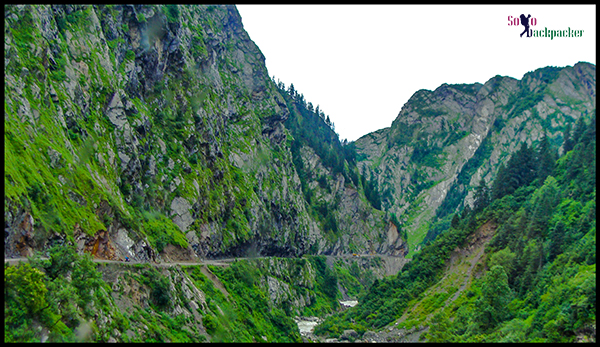
The road from Joshimath to Badrinath passes through Govindghat, a small town, from where you can trek to Ghangaria, the base station for Valley of Flowers and Hemkund Sahib Trek. Because of the holy Sikh Gurudwara at Hemkund Sahib, a large number of Sikh devotees were visible on the road. Amidst the harsh conditions of the high mountains and the tough terrain, scores of Splendors, CD Deluxe, TVS Stars, Pulsars, Scooters and Bullets were plying on the road. Most of them was also having a pillion on the back seat. I always believed that a powerful bike of at least 200 CC is required to ride in the High Himalayas, but the hundreds of splendors parked in the parking lot at Govindghat proved me wrong in a moment. And, then we found 5 cyclists, who were riding on their simple bicycles to the shrine of Badrinath. It really required lot of efforts and much more determination to paddle a bicycle in that rough terrain. After a roller coaster ride on the curvy roads from Joshimath, we reached to Badrinath by in one hour and 45 minutes.
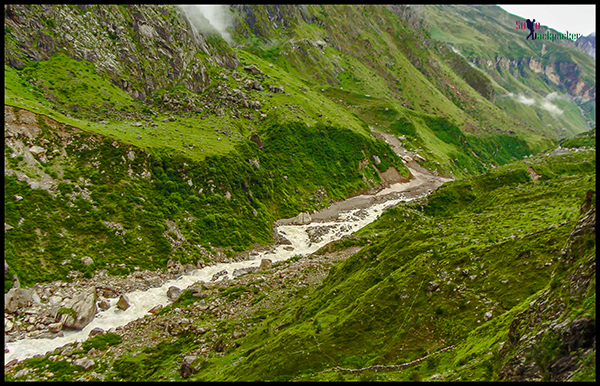

Badrinath, at an elevation of 3,130 meters (10,250 feet), is the abode of Lord Vishnu. Situated in the lap of Nar-Narayan mountain range with the towering Neelkanth peak (6,597mts) in the background, Badrinath is one of the most revered Hindu shrines of India. Badrinath is a fairly large town. It has decent accommodation options, restaurants, ATMs and other facilities from Budget to Mid-Range prices. Bus stand is approx 1 km from the main temple, so after leaving our shared jeep, we walked towards the temple. Slightly away from the bus stand, we booked a decent guesthouse for the night stay. There is nothing like check-in time and check-out time. Whenever you book, the room belongs to you for the next 24 hours. At least, most of the cheaper guesthouses work like this.
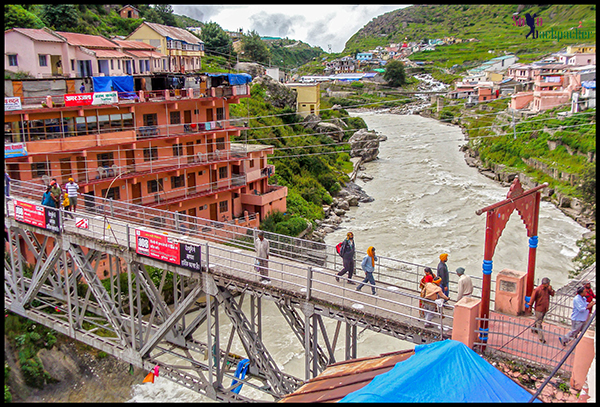
After taking some rest, we proceeded towards Sri Badrinath Temple. The streets of Badrinath is full of the shops selling religious offerings, idols, photographs etc. There are many pure vegetarian restaurants on the way. After passing through the streets, we reached on the bank of Alaknanda River. From there, a bridge supported on the iron pillar leads to the temple area. Slightly away from the bank of Alaknanda River, the present-day Badrinath Temple is the most revered pilgrimage destination among the Char Dhams of Hindu religion. At an altitude of 3133 mts the temple of Shri Badrinathji dates back to the Vedic times, when Adi Shankaracharya established a sacred math here (Legends also indicate that the math was established by him at present day Joshimath). Also known as ‘Vishal Badri’, Badrinath is one of the Panch Badris.

After crossing the iron bridge on the river, there is a hot water pool on the right side. Known as Tapta Kund, it is a famous hot spring, where hot water is available throughout day and night. The water of the kund is believed to have medicinal properties. The pilgrims used to bath in the pool before offering their prayers at the temple. Separate enclosure is there for the ladies. During the night, it becomes unbearably hot to bath.
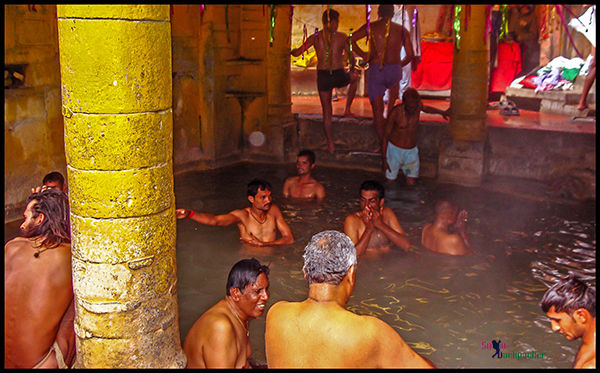
A flight of stairs leads to the main gate and then into the Badrinath temple. The temple is divided into three parts – the ‘Garbha Griha’ or the sanctum sanctorum, the ‘Darshan Mandap’ where the rituals are conducted and the ‘Sabha Mandap’ where devotees assemble. The Garbha Griha portion has its canopy covered with a sheet of gold offered by Queen Ahilyabai Holkar. The complex has 15 idols especially attractive is the one-meter high image of lord Badrinath, finely sculpted in black stone. It represents Lord Vishnu seated in a meditative pose called Padmasan.
Lord Badrinath is sitting meditating in the Padmasana (Lotus Yogic posture). As you look at the Deities, standing to the right side of Badrinarayana is Uddhava. To the far right side are Nara and Narayana. On the left side are Kubera, the god of wealth, and a silver Ganesh. Garuda is kneeling in front, to the left of Badrinarayana.

The Badrinath temple opens at 0430 hrs & closes at 1300 hrs. Once again it opens at 1600 hrs & closes at 2100 hrs after the divine song Geet Govind. Special poojas are also performed on behalf of individuals. Every pooja must be preceded by a holy dip in the Tapta Kund. Some of the special morning poojas are Abhishek, Mahaabhishek, Geeta Path. Some special evening poojas are Aarti & Geet Govind. Such poojas are to be booked in advance.
While returning from the temple, we saw that the guards were instructing to the people to step aside from the gate. A man appeared from that gate with a Golden Rod in his hand. A guard informed us that he is the present Rawal, chief priest of the temple. While going inside the temple, he should not be touched by anyone. Rawal is the administrator-Pujari of the temple and well versed in pooja ceremonials & Sanskrit language.
After visiting the temple of Lord Badrinath, we went to Mana Village and Vasudhara Falls. In the night, we returned to the temple again and enjoyed the pooja (prayer) one more time.
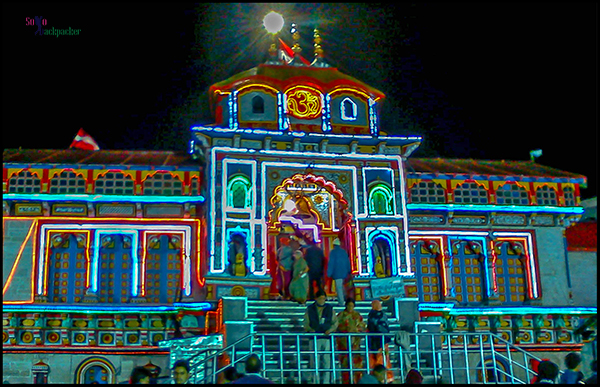
The shrine of Badrinath remains snowbound for nearly six months during the winter season. During winter, most of the residents from Badrinath arrive in Joshimath to pass the harsh season. The idol of Lord Vishnu i.e., Lord Badrinarayan from Badrinath also brought dowm to Narasimha Temple at Jyotirmath (Joshimath) by the priests in a spectacular ceremony. That’s why Joshimath is also known as the winter shrine of Badrinath.



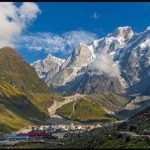
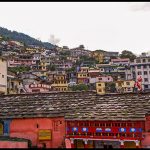

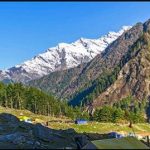

HI
YOUR BLOG IS AWESOME, IM PLANNING TO GO THERE IN THE MONTH OF NOVEMBER BY 20TH, PLEASE GUIDE ME FOR THE SAME
ALSO I HAVE SEEN ONLY TWO PAGES OF YOUR SITE CAN YOU PLEASE SHARE LINK OF OTHER 3 PART ( SO FAR HAVE SEEN ONLY PART 1 AND PART 2( Visiting the Devbhoomi in Uttarakhand-Part 2/5, Badrinath, Mana and Vasudhara Fall) PLEASE SHARE FOR REST OF THE PART.
CAN I SEE SNOW IN AULI AT THIS TIME
Click on the Uttarakhand state under the Categories on Home Page. You will get all the posts on this state.
Im sorry but rest of the page is not available
please share link for part 3 to 5
Thanks
Very nicely described. and beautiful photographs.
I and my wife are also planning to visit VOF in Aug 2nd week.
I have not booked any group or hotel. Hope will get there budget accommodation and guide for VOF.
Thank you. It shouldn’t be a problem. You can easily get the accommodation as well as the guide. In worst case, the gurudwara is always there for any help. Have a nice trip. 🙂
Hi, great to read such a detailed account! Would you know how long does it take to reach Badrinath from Lohajung? I’m going to be in Lohajung next week to go ahead to Roopkund (!!), and was wondering if I could fit in Badrinath quickly in a couple of days, before my trek begins.
Thank you! Wish you more travels!
Hi, You can easily visit Badrinath in two days from Lohajung. Rather, instead of going to Lohajung on the first day, proceed to Karnaprayag from Tharali. If you are going to Lohajung from Kathgodam, Tharali is about 45 kms before Lohajung and Karnaprayag is 47 kms from Tharali. But, if you are going to Lohajung via Haridwar, Karnaprayag will be on the way before Tharali. From Karnaprayag, take a direct bus to Badrinath (130 kms, 4-5 hours). There are plenty of buses till 2 PM at frequent intervals. After 2 PM, you may not be able to get a direct bus, because route gets closed beyond Joshimath due to the gate system. It means , after 5.30 PM, no bus is allowed to proceed beyond Joshimath towards Badrinath. In that case, you can go to Joshimath, stay there in the night and then go to Badrinath on the next day. Joshimath to Badrinath is about 1 hour 30 minutes drive. Badrinath temple is just one km walk from bus stand. You can come back following the same route till Karnaprayag and then to Tharali and proceed further to Lohajung to join your trek. Have a nice trip.
Hi Nice Post
Can u also pls tell me how to get to satopanth and how much does the guide charges
Thank you
Azad Rana
Hi, Satopanth Trek starts from Mana Village. You need to get the permit from the Pradhan of Mana Village or SDM office. I don’t have any idea about the guide charges.
Ok Thank you
Solo Backpacker, Your narration style is very nice and easy.The photos are good too.
From Mana it takes 3 days to reach Satopanth lake. It is a 25Km trek one way The first night halt is at Laxmivan and the second one is at Chakratheerth. The return usually takes 2 days. Typical guide charges are around Rs.2000 – 2500 per person per day depending upon the kind of services you need and include B,L,D,Tents, sleeping bags and porter charges. You can hire guide and porter from Mana. One very reliable guide is Mr. Mannu Rawat. His contact is 9412966171.We had tried his services in June 2015.
Thank You very much for this information. 🙂
Very good documentation. I went through your post before visiting Valley of Flowers in 2012 and it helped me a lot. I would like to appreciate your beautiful sense of capturing the photographs from the right and at right moment. We were not fortunate to have good snaps of VoF because of heavy fogs.
By the way, how to post in this site? and if I want to contact you, where should I drop a line?
Hi, Thanks for liking our post. I am happy that you had a great time visiting Valley of Flowers. You can post your photographs in the forum section of this website. First, go to forum section and register with an e-mail id. Then, you can select Trekking in Himalayas, start a new topic as “Our Trip Report to Valley of Flowers” and post your pics there. It will be our pleasure to have them on this website. You can contact by dropping some lines at avanish@solobackpacker.com . Enjoy, Keep Travelling.
Very well written. it is really a colossal task to cover each and every bit on foot. Though it seems strange to have covered the return journey from Shri Hemkund Sahib in an hour only.
Thanks Harmeet..I really don’t recall now, if I returned back to Ghangharia from Hemkund in one hour only. But, I think 6 kms descend (trail distance) with some shortcuts is doable in an hour. I might had returned in an hour, because once we descended 12 kms distance (trail distance) of Mata Vaishno Devi in 2 hours 15 minutes only. 🙂
One of the most beautifully depicted, intimately described travelogue. You made me feel visiting this place. Thanks !
very good naration and photos
Wonderful photoblog… nature at its best, thanks for sharing this 🙂
Extremely fascinated to view the pictures posted by you.
Regards
Anish Dutta
Thanks sir.